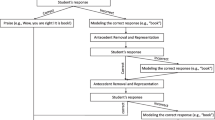Abstract
The impact of stimulus size and presentation on choice during a preference assessment was investigated using a modified multiple-stimulus without replacement (MSWO) technique. Stimuli were either presented with a uniform magnitude, as determined by mass, or in a manner consistent with caregiver report of reinforcer consumption. While both assessment procedures identified the same top three preferred items in three out of five cases, greater variability in the preference rank of less preferred items was observed between assessments.

Similar content being viewed by others
References
DeLeon, I. G., & Iwata, B. A. (1996). Evaluation of a multiple-stimulus presentation format for assessing reinforce preferences. Journal of Applied Behavior Analysis, 29, 519–533.
DeLeon, I. G., Chase, J. A., Frank-Crawford, M. A., Carreau-Webster, A. B., Bullock, C. E., & Jennett, H. K. (2014). Distributed and accumulated reinforcement arrangements: evaluations of efficacy and preference. Journal of Applied Behavior Analysis, 47, 1–21.
DeLeon, I. G., Frank, M. A., Gregory, M. K., & Allman, M. J. (2009). On the correspondence between preference assessment outcomes and progressive-ratio schedule assessments of stimulus value. Journal of Applied Behavior Analysis, 42, 729–733.
DeRosa, N. M., & Roane, H. S. (2015). Preference and demand characteristics of reinforcement: practical extensions. In F. D. DiGennaro Reed & D. D. Reed (Eds.), Autism service delivery: bridging the gap between science and practice. New York, NY: Springer.
Fisher, W. W., Piazza, C. C., Bowman, L. G., & Amari, A. (1996). Integrating caregiver report with a systematic choice assessment to enhance reinforce identification. American Journal on Mental Retardation, 101, 15–25.
Pace, G. M., Ivancic, M. T., Edwards, G. L., Iwata, B. A., & Page, T. J. (1985). Assessment of stimulus preference and reinforcer value with profoundly retarded individuals. Journal of Applied Behavior Analysis, 18, 249–255.
Reed, D. D., Kaplan, B. A., & Becirevic, A. (2015). Basic research on the behavioral economics of reinforcer value. In F. D. DiGennaro Reed & D. D. Reed (Eds.), Autism service delivery: bridging the gap between science and practice. New York, NY: Springer.
Reed, D. D., Niileksela, C. R., & Kaplan, B. A. (2013). Behavioral economics: a tutorial for behavior analysis in practice. Behavior Analysis in Practice, 6, 34–54.
Steinhilber, J., & Johnson, C. (2007). The effects of brief and extended stimulus availability on preference. Journal of Applied Behavior Analysis, 40, 767–772.
Wacker, D. P., Berg, W. K., Wiggins, B., Muldoon, M., & Cavanaugh, J. (1985). Evaluation of reinforcer preferences for profoundly handicapped students. Journal of Applied Behavior Analysis, 18, 173–178.
Whelan, R., Barnes-Holmes, D., & Dymond, S. (2006). The transformation of consequential functions in accordance with the relational frames of more-than and less-than. Journal of the Experimental Analysis of Behavior, 86, 314–335.
Author information
Authors and Affiliations
Corresponding author
Ethics declarations
All aspects of the study complied with the ethical guidelines set forth by the Behavior Analyst Certification Board.
Informed Consent
Informed consent was obtained from all individual participants included in the study.
Conflict of Interest
The authors declare that they have no conflict(s) of interest.
Additional information
An erratum to this article is available at http://dx.doi.org/10.1007/s40617-016-0162-8.
Rights and permissions
About this article
Cite this article
Moore, J.W., Radley, K.C., Dart, E.H. et al. The Impact of Stimulus Presentation and Size on Preference. Behav Analysis Practice 10, 172–177 (2017). https://doi.org/10.1007/s40617-016-0148-6
Published:
Issue Date:
DOI: https://doi.org/10.1007/s40617-016-0148-6




